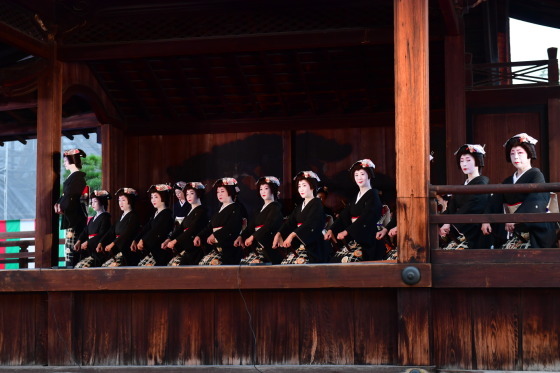Kyoto International Film and Art Festival Opens with Traditional Ceremony
2018/10/11 Report

The Kyoto International Film and Art Festival opened Thursday, October 11. Filmmakers and VIPS who had just walked the red carpet joined reporters and other guests at Kyoto’s historic Nishi-Honganji temple at 2pm. There they were treated to a traditional performance, with two dozen geisha chanting a welcome and playing shamisen. It was a perfect fit for the World Heritage Site, which is over four centuries old.
An opening greeting was given by veteran director Sadao Nakajima. He remarked that it is a rare opportunity for the opening ceremony of a film festival to be held in such a historically important location. But he said that it is also fitting, since Kyoto is known as “Japan’s Hollywood” and is where the earliest Japanese films were shot. He also thanked the people of Kyoto for their hospitality, which has made possible to get to the fifth edition of KIFF. Nakajima then officially announced the festival had opened.
MCs Takashi Fuji and Satomi Hirano introduced Ichiya Nakamura, who is part of the festival’s executive committee. Nakamura said that the message of this year’s festival is “Kyoto is on air,” and it is not limited to a film festival, but rather is a package of films and art, and also includes workshops for children to inspire their creativity.
The mayor of Kyoto City, Daisaku Kadokawa thanked the festival’s organizer, Yoshimoto Kogyo, for doing so much to help the city. He remarked that the combination of a film festival with the United Nations’ Sustainable Development Goals, or SDGs, is quite rare. He went on to say that the Japanese government as well as Kyoto itself are working to promote filming in the city.
Hirano Furukawa of Kyoto Prefecture delivered a message from Governor Keiji Yamada, who expressed his gratitude to Nishi-Honganji temple for welcoming the festival. The governor commented that Kyoto is a place where innovation is built on tradition, and he hopes that that trend continues with more films being shot in Kyoto.
Next, Hiroshi Matsuzaka of Japan’s Agency for Cultural Affairs spoke. He said that the entire agency will move to Japan’s cultural capital, Kyoto, in 2021 and his office already moved to the city last year. He said the agency is working to promote film as well as many different cultural fields. Matsuzaka mentioned that the city offers innovation in other fields, remarking that that Dr. Tasuku Honjo who recently won the Nobel Prize in physiology or medicine is based in Kyoto.
Mr. Hideo Suzuki from the Ministry of Foreign Affairs said that the 5th edition of KIFF marks a new era. He said the festival can connect hearts with hearts, leading to world peace. He remarked that the focus of his work is passing things on to the next generation, and so each generation must learn about the importance of SDGs. He said the festival is a good opportunity to do so, with events such as games and short films about SDGs. He hopes that people who attend the festival will go out and start action toward contributing to sustainability.
Kaoru Nemoto, the director of the UN Information Center, remarked that the SDGs have been formally adopted by the world at the United Nations, but the festival brings this to the people, with events such as the SDGs Kagetsu live performances and short films. Nemoto remarked that the host city was also home to the Kyoto Protocol, and that should help people think about the importance of SDGs.
Prime Minister Shinzo Abe sent a message, saying that Japan is facing a lot of issues, but through efforts in film, art and communication, the festival gives people determination to overcome those issues and create a world of cooperation.
Film producer Kazuyosi Okuyama said that a film festival is often the starting point of new films, and in that regard, with its 5th edition KIFF has developed into a full-fledged festival.
Actress Yoshiko Mita, who appears in the 1992 film Tōki Rakujitsu which is screening in the festival, expressed her thanks to the festival for inviting her and giving the film its first screening in over 20 years. She also thanked Okuyama, who produced the film.
Finally, festival’s prizes were awarded. The “Most Respect” prize went to the lead actors of the Chinese historical film Cao Cao and Yang Xiu, who are regarded as national treasures in China.
The Shozo Makino Award, which was established in 1958 to honor the man known as “the father of Japanese filmmaking,” went to Yasuo Furuhata. The director is known for 19 different collaborations with late actor Ken Takakura, including Poppoya and Dearest.
The Toshiro Mifune Award, named after the iconic actor, went to popular actor Koichi Sato.
Miyuki Kimura of Yoshimoto Kogyo mentioned that the scope of the festival has been widened with more activities, and the festival will be further enriched be the people attending.
Near the close of the ceremony, there was a message from legendary actress Machiko Kyo, who said she would like to have been able to attend the festival, as she remembers filming the 1950 classic Rashomon in Kyoto. It was a touching reminder of the city’s rich film history.

- Share on Facebook
- Share on Twitter





